How Do You Know How Many Triangles Are Possible
Triangle Figure
Bending-Side-Angle (ASA)
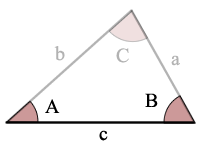
A = angle A
B = angle B
C = bending C
a = side a
b = side b
c = side c
P = perimeter
s = semi-perimeter
One thousand = area
r = radius of inscribed circle
R = radius of circumscribed circle
Calculator Use
Each calculation option, shown below, has sub-bullets that listing the sequence of methods used in this calculator to solve for unknown bending and side values including Sum of Angles in a Triangle, Law of Sines and Law of Cosines. These are Not the Only sequences you could utilise to solve these types of problems.
- Run into too these Trigonometry Calculators:
- Police force of Cosines Calculator
- Police of Sines Calculator
Solving Triangle Theorems
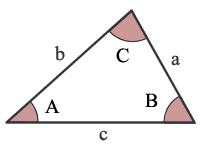
AAA is Angle, Angle, Angle
Specifying the 3 angles of a triangle does not uniquely identify one triangle. Therefore, specifying ii angles of a tringle allows you to summate the third bending only.
Given the sizes of 2 angles of a triangle you can calculate the size of the 3rd bending. The total volition equal 180° or π radians.
C = 180° - A - B (in degrees)
C = π - A - B (in radians)
AAS is Angle, Angle, Side
Given the size of 2 angles and 1 side opposite ane of the given angles, y'all can calculate the sizes of the remaining i angle and ii sides.
use the Sum of Angles Rule to notice the other bending, and so
use The Police of Sines to solve for each of the other 2 sides.
ASA is Angle, Side, Angle
Given the size of two angles and the size of the side that is in between those two angles you can summate the sizes of the remaining 1 bending and 2 sides.
utilise the Sum of Angles Dominion to find the other angle, then
employ The Law of Sines to solve for each of the other two sides.
ASS (or SSA) is Angle, Side, Side
Given the size of 2 sides (a and c where a < c) and the size of the bending A that is non in betwixt those 2 sides y'all might be able to calculate the sizes of the remaining 1 side and ii angles, depending on the post-obit conditions.
For A ≥ ninety° (A ≥ π/two):
If a ≤ c at that place there are no possible triangles
Case:
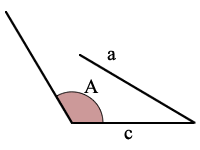
If a > c there is 1 possible solution
- apply The Police of Sines to solve for bending C
- use the Sum of Angles Rule to find the other angle, B
- use The Law of Sines to solve for the last side, b
- Instance:
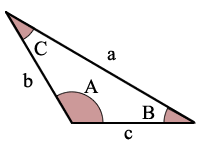
For A < 90° (A < π/ii):
If a ≥ c there is one possible solution
- use The Law of Sines to solve for angle C
- utilise the Sum of Angles Rule to discover the other angle, B
- use The Law of Sines to solve for the last side, b
- Example:

If a < c we have 3 potential situations. "If sin(A) < a/c, there are two possible triangles satisfying the given conditions. If sin(A) = a/c, at that place is one possible triangle. If sin(A) > a/c, there are no possible triangles." [1]
sin(A) < a/c, there are two possible triangles
solve for the two possible values of the 3rd side b = c*cos(A) ± √[ a2 - c2 sin2 (A) ][1]
for each set of solutions, use The Police force of Cosines to solve for each of the other two angles
present 2 full solutions
Example:
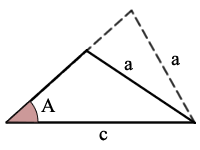
sin(A) = a/c, there is one possible triangle
use The Law of Sines to solve for an angle, C
utilise the Sum of Angles Rule to discover the other angle, B
use The Law of Sines to solve for the last side, b
Example:
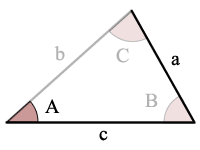
sin(A) > a/c, at that place are no possible triangles
Error Find: sin(A) > a/c and then there are no solutions and no triangle!
Example:
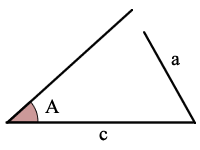
SAS is Side, Bending, Side
Given the size of 2 sides (c and a) and the size of the angle B that is in between those 2 sides you tin calculate the sizes of the remaining ane side and 2 angles.
apply The Police of Cosines to solve for the remaining side, b
make up one's mind which side, a or c, is smallest and apply the Police of Sines to solve for the size of the reverse bending, A or C respectively.[2]
use the Sum of Angles Rule to find the last angle
SSS is Side, Side, Side
Given the sizes of the 3 sides you can calculate the sizes of all 3 angles in the triangle.
use The Law of Cosines to solve for the angles. You could too utilize the Sum of Angles Rule to detect the final angle once y'all know 2 of them.
Sum of Angles in a Triangle
In Degrees A + B + C = 180°
In Radians A + B + C = π
Constabulary of Sines
If a, b and c are the lengths of the legs of a triangle opposite to the angles A, B and C respectively; and so the law of sines states:
a/sin A = b/sin B = c/sin C
Solving, for example, for an angle, A = sin-1 [ a*sin(B) / b ]
Police force of Cosines
If a, b and c are the lengths of the legs of a triangle opposite to the angles A, B and C respectively; and then the constabulary of cosines states:
a2 = c2 + b2 - 2bc cos A, solving for cos A, cos A = ( b2 + c2 - a2 ) / 2bc
b2 = a2 + c2 - 2ca cos B, solving for cos B, cos B = ( c2 + a2 - bii ) / 2ca
cii = b2 + a2 - 2ab cos C, solving for cos C, cos C = ( a2 + b2 - c2 ) / 2ab
Solving, for example, for an angle, A = cos-ane [ ( btwo + ctwo - a2 ) / 2bc ]
Other Triangle Characteristics
Triangle perimeter, P = a + b + c
Triangle semi-perimeter, s = 0.5 * (a + b + c)
Triangle expanse, One thousand = √[ s*(due south-a)*(s-b)*(southward-c)]
Radius of inscribed circle in the triangle, r = √[ (s-a)*(due south-b)*(s-c) / south ]
Radius of circumscribed circumvolve effectually triangle, R = (abc) / (4K)
References/ Further Reading
[i] Weisstein, Eric Westward. "ASS Theorem." From MathWorld-- A Wolfram Web Resource. ASS Theorem.
[2] Math is Fun - Solving SAS Triangles
Zwillinger, Daniel (Editor-in-Chief). CRC Standard Mathematical Tables and Formulae, 31st Edition New York, NY: CRC Press, p. 512, 2003.
Weisstein, Eric W. "Triangle Properties." From MathWorld-- A Wolfram Web Resources. Triangle Properties.
Math is Fun at Solving Triangles.
Source: https://www.calculatorsoup.com/calculators/geometry-plane/triangle-theorems.php
0 Response to "How Do You Know How Many Triangles Are Possible"
Post a Comment